

All bird traits are controlled by a mixure of genes, just like our genes control what our hair and eye color are. We get two sets of genes from our parents. So what happens if our mother has blue eyes and our father has brown eyes? We will get genes for two different colors. So what color will our eyes be? Not all of our genes can be expressed at once. Our body controls which genes show up through gene expression. There are several kinds of gene expression; dominant, recessive and sex-linked are the three we'll worry about.
A dominant gene is
expressed no matter what. If it is there in your or your bird's body it will show up. A
recessive gene can only be displayed if BOTH the genes received from the parents are the
same recessive gene. Think of it this way: a dominant gene is like the sun and recessive genes
are like the stars. If the sun is in the sky the stars cannot be seen even though they are there.
Likewise, when a dominant gene is present the recessive genes are all hidden. But if there are no
dominant genes around we can see recessive genes. In humans, the gene for brown eyes is dominant
and the gene for blue eyes is recessive. So if we received one brown gene from dad and one blue
gene from mom only the brown gene would be expressed. Our eyes would be brown (Image 1).

If both parents have brown eyes their child's eyes will also be brown.

If both parents have blue eyes their child's eyes will also be blue.

Unfortunately, it's not always that simple. So far all our parents have been homozygous,
they carry two of the same genes. But not all parents are like this. Take another look at Image
1. The child is carrying two different genes for color, one from each parent. This is called
heterozygous. What if this heterozygous child decides to have children? Which gene will
they inherit? Luckily, we have an easy method of determining what the children might be like.
A Punnett square (below) is a quick way to find out the chances of a child inheriting a certain
gene. The father's genes are each entered at the top and the mother's genes are entered on the
side. The four boxes in the center are the possible combinations of those genes. Let's try one
together.
First, draw a square like the one below.
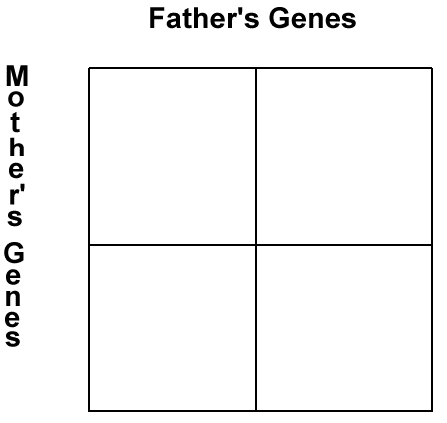
Next, enter the information on the parents. Let's have the child from Image 1 be the father and give the mother blue eyes. We use capital letters to sybolize dominant genes, in this case a capital "B" for brown, and lower case letters to sybolize recessive genes, in this case a little "b."

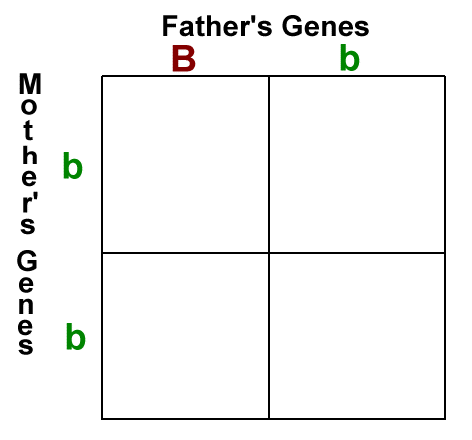
Now we combine the parents' genetic information in the boxes to find out the possible children.
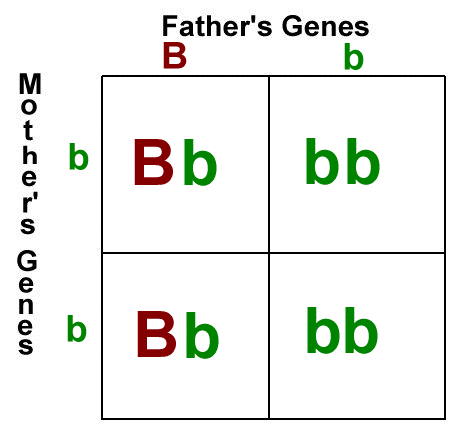
The results out of four children: two of the children will be heterozygous with brown eyes and the other two will be homozygous for blue eyes. Let's try some more. What if both parents are heterzygous for brown eyes? You'd get the following:
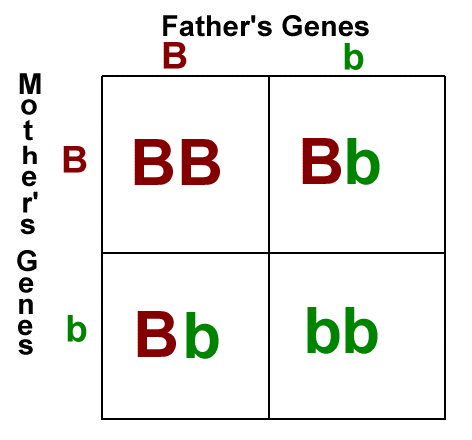
One in four children will have brown eyes (homozygous), two will have brown eyes but carry the gene for blue (heterozygous) and one will have blue eyes (homozygous).
Now that you know how it's done let's see if you can do a couple on your own. Try these two:

Sex-linked traits act just like recessive ones except they also bow to the will of the sex of the
child. Genes are carried on things called chromosomes. Most people already know that
in humans the man has an X and Y chromosome and the female has two X chromosomes. This is the
reason that the only the man can determine the sex of the child. Women can only provide X
chromosomes while a man can provide either. Now, the X chromosome is bigger and can carry more
genetic information on it than the Y can. This is where sex-linked traits come in. Because the
X is bigger it means that some genes carried on it are not carried on the Y chromosome. These
genes can be expressed even without a corresponding partner on an X chromosome. They also cannot
be blocked out unless there is another X chromosome carrying a dominant partner.
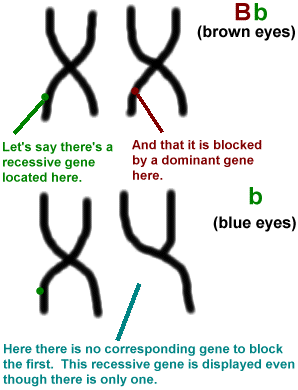
One human sex-linked trait is Hemophilia. Hemophilia is a disease that keeps a person's blood from clotting when he is cut. Hemophiliacs can easily bleed to death and must be very careful not to injure themselves. Many also take daily injections to help the problem. Because hemophilia is a sex-linked disease most of the people who have it are men. Women can carry the gene for hemophilia but will not be affected by it because their second X chromosome will block it out with a healthy gene. They must have two copies of the defective gene to display the disease. Inheriting two copies is highly unlikely. Men carrying hemophilia do not have another X chromosome so they will have hemophilia with only one gene for it. Mothers carrying one gene for hemophilia take a great risk with having children because there is a 50% chance their sons will end up with the disease. Here's how it works:
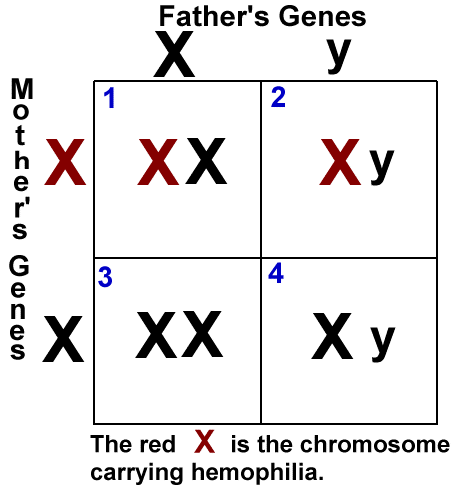
As you can see, at least half of her children (boxes 1 and 2) will inherit the defective gene. One, a daughter, will only carry the gene. The other, a son, will have the disease hemophilia. The last two children (boxes 3 and 4) will carry healthy genes. Of course these are only the posibilities of what her children could end up with. She could very well end up giving it to all her children or none at all. It's just a matter of chance. Now let's take a look at what will happen if this woman's hemophiliac son has children with a healthy woman:
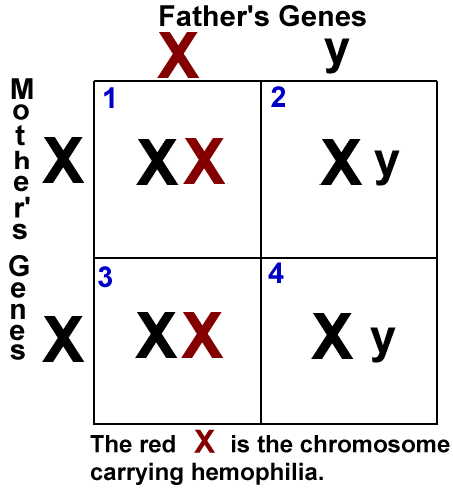
In this case half the children will still inherit the gene. All the sons will be safe but all the daughters will end up carrying hemophilia and could end up passing it on to their children. It is in this way that sex-linked genes can disappear and reappear from generation to generation.
Not all sex-linked traits are bad. Many of the colors you see in birds like lutino, pearl and cinnamon are controlled by sex-linked genes. But before we can get into bird sex-linked traits there's something you need to know: BIRDS DO NOT HAVE X AND Y CHROMOSOMES. What I'm about to tell you may seem very confusing, but really it's not. Birds carry different chromosomes than humans, W and Z I believe, but this is not important (for our purposes we'll stick to X and Y). What IS important is that in birds the male carries two of the same chromosome (like XX) and the female carries two different ones (XY). This means that it is hens who determine the sex of the chicks in birds and that they are more likely to show up with sex-linked traits. The punnett squares and such all work the same way, you just have to remember to reverse the X and Y's from that of humans:

Let's try another punnet square, this time for birds. I have a lutino male and I want to see what I'll get if I breed him to a normal hen. In order for a male to display lutino he has to be carrying it on both X chromosomes. We'll color the lutino X's with yellow to tell them apart.
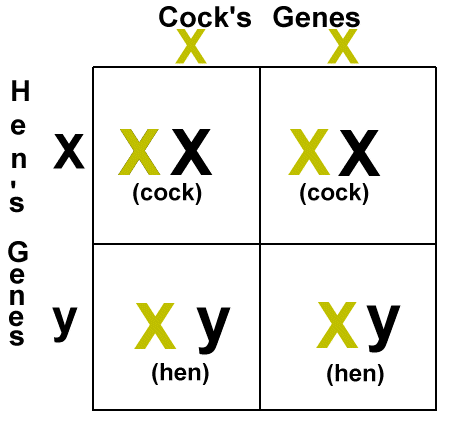
All of the babies will be carrying a gene for lutino. The cocks, however, will only be split and will not show up lutino. The hens will both be visually lutino because they have no second X chromosomes to block out the gene. The results: 50% males split for lutino and 50% lutino hens. Let's try one more. This time I want to mate a cinnamon hen to a cock split to cinnamon (carrying but not displaying). She will only need the one gene to show the color.
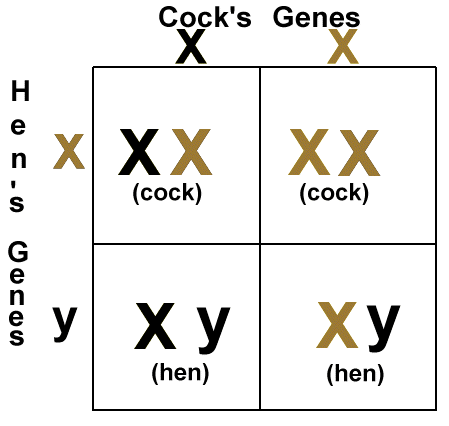
Half of the babies will be cinnamon (both sexes), one will be split (a male) and one will be normal (female). The results: 25% males split to cinnamon, 25% cinnamon males, 25% cinnamon females and 25% normal females. Sex-linked traits are also nice because they can tell you the sex of your chicks. Just look back to the lutino example above, you know that all lutino chicks are going to be hens and all other colors will be males.
Well that's it for now. Congratulations, you survived my crash course in genetics!

All articles and images contained on this site are © 1998, 1999, 2000 by Feisty Feathers unless otherwise noted and may not be reprinted or used in any way without the author's permission.